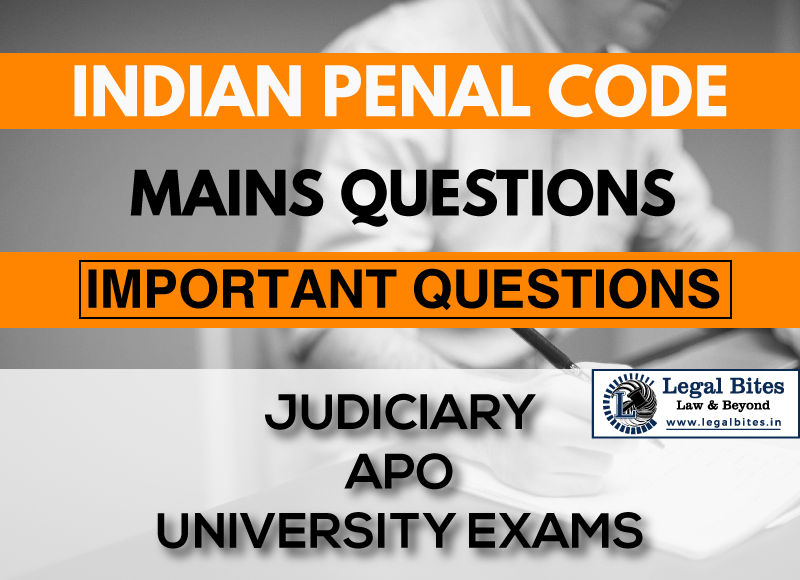Liladhar threatens to publish a defamatory libel concerning Roopa Devi unless she gives him money. Roopa Devi, who is an unmarried girl, gives him money. What offence has been committed by Liladhar?
Question: Liladhar threatens to publish a defamatory libel concerning Roopa Devi unless she gives him money. Roopa Devi, who is an unmarried girl, gives him money. What offence has been committed by Liladhar?] Find the answer to the mains question only on Legal Bites. [Liladhar threatens to publish a defamatory libel concerning Roopa Devi unless she gives him… Read More »
;
Question: Liladhar threatens to publish a defamatory libel concerning Roopa Devi unless she gives him money. Roopa Devi, who is an unmarried girl, gives him money. What offence has been committed by Liladhar?] Find the answer to the mains question only on Legal Bites. [Liladhar threatens to publish a defamatory libel concerning Roopa Devi unless she gives him money. Roopa Devi, who is an unmarried girl, gives him money. What offence has been committed by Liladhar? [UKCJ. 2003] Answer ...
Question: Liladhar threatens to publish a defamatory libel concerning Roopa Devi unless she gives him money. Roopa Devi, who is an unmarried girl, gives him money. What offence has been committed by Liladhar?]
Find the answer to the mains question only on Legal Bites. [Liladhar threatens to publish a defamatory libel concerning Roopa Devi unless she gives him money. Roopa Devi, who is an unmarried girl, gives him money. What offence has been committed by Liladhar? [UKCJ. 2003]
Answer
Section 383. Extortion.— Whoever intentionally puts any person in fear of any injury to that person, or to any other, and thereby dishonestly induces the person so put in fear to deliver to any person any property or valuable security, or anything signed or sealed which may be converted into a valuable security, commits “extortion”.
The essential ingredients of the offence of extortion are:
- intentionally putting a person in fear of injury;
- the purpose of which is to dishonestly induce the person to put in fear, and
- to deliver property or valuable security
The fear of injury contemplated under this section need not necessarily be bodily harm or hurt. It will include injuries to the mind, reputation or property of the person.
The word ‘injury’ is defined in section 44 as denoting ‘any harm whatever illegally caused to any person, in body, mind, reputation or property.
Relevant case law on the present facts of the case is of Romesh Chandra Arora v. State [AIR 1960 SC 154]. In this case, the accused had written letters to one X, enclosing photographs of the daughter of X in the nude and were of a character, which if made public, would undoubtedly compromise the reputation of the girl as well as her father X. The accused demanded ‘hush money’ from X and threatened X stating that he would circulate the photographs to the relatives of the girl if the money was not paid. In this case, the appellant could have been convicted of extortion under section 384 read with
section 511, IPC, 1860 instead. However, dismissing the appeal, the Supreme Court held that
the offence of criminal intimidation was committed by threatening X. He was convicted for criminal intimidation under section 506, IPC.
So, in the present case at hand, Liladhar when threatens to publish a defamatory libel concerning Roopa Devi, an unmarried girl unless she gives him money is said to have caused fear of injury to the reputation of Roopa Devi which compelled her to give the money to Liladhar. Hence, Liladhar shall be made punishable for committing the offence of Extortion under section 385, IPC.
Important Mains Questions Series for Judiciary, APO & University Exams
- IPC Mains Questions Series Part I: Important Questions
- IPC Mains Questions Series Part II: Important Questions
- IPC Mains Questions Series Part III: Important Questions
- IPC Mains Questions Series Part IV: Important Questions
- IPC Mains Questions Series Part V: Important Questions
- IPC Mains Questions Series Part VI: Important Questions
- IPC Mains Questions Series Part VII: Important Questions
- IPC Mains Questions Series Part VIII: Important Questions
- IPC Mains Questions Series Part IX: Important Questions
- IPC Mains Questions Series Part X: Important Questions


